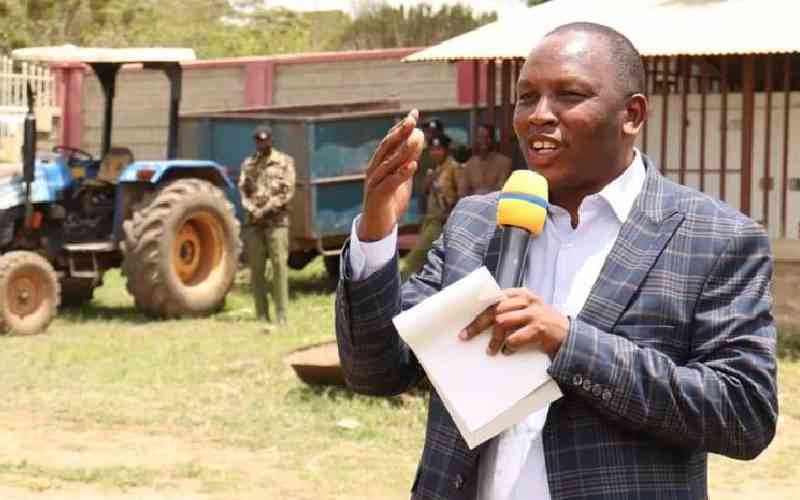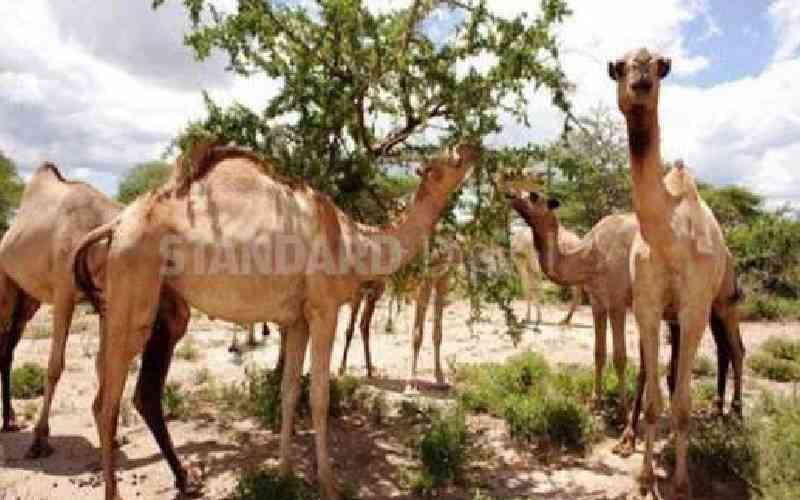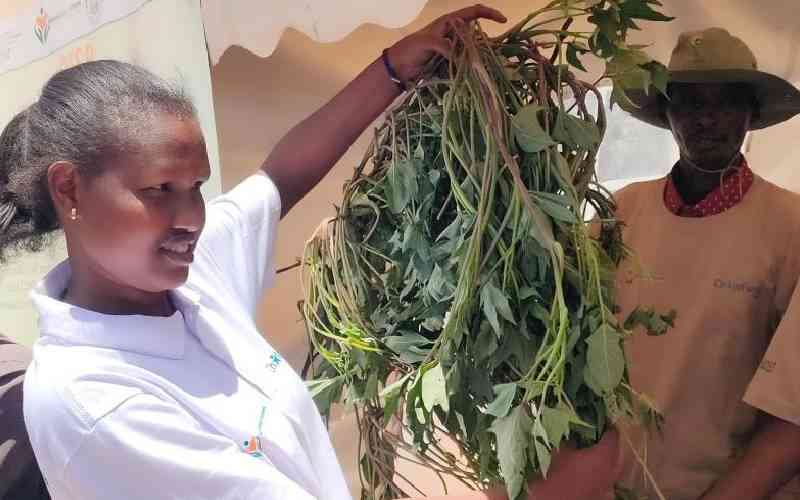 |
|
Police officers collect bodies of those who were killed during the Baragoi attack where more than 40 officers were gunned down. [PHOTO: FILE/STANDARD] |
By BOAZ KIPNGENO
Samburu: The beautiful valleys and hills covered by thick shrubs as observed from Baragoi trading centre may not reveal the hidden danger. But perhaps the amount of money that the national and county government and other non-governmental organisations have spent after deadly battles can not be quantified.
Millions are spent in efforts to end the cattle rustling culture, treat casualties and feed the displaced residents.
More money that could be directed to development projects too end up in peace initiatives.
The anticipation for the new Constitution to address historical injustices through devolution may be slowly fading away more so in Samburu County, which is surrounded by pastoralist communities that have made a career stealing livestock from every corner.
The raids between the Pokot, Samburu and Turkana communities in Baragoi are depriving Samburu County of its development progress.
In Baragoi, lives have been lost, women have become widows and thousands thrown to the cold bushes as hunger becomes inevitable.
Residents have never known peace; the regular sounds of gunshots and wails have become routine to their ears.
Uncontrollable culture
This rogue culture behavior has not only proved uncontrollable, but also a costly one. Apart from Sh88 million project, Samburu North Integrated Livelihood and Food Security that Kenya Red Cross Society initiated last year in Baragoi’s Kurungu village, another Sh25 million was spent last year in assisting the displaced and in treating the injured victims.
The project is aimed at creating an alternative source of livelihood for the locals after the decade long rustling between Turkana and Samburu.
Last year, 216 people were killed and 213 others injured in cattle rustling incident, according to Kenya Red Cross Society. Samburu County’s Kenya Red Cross Society (KRCS) Coordinator, Mugambi Gitonga, says 41 were killed between January and May and 175 others killed between June and December. Over 10,000 others from 1,735 households were displaced and pitched tents in various camps within the region between November and December when clashes heightened between Samburu and Turkana communities.
According to Gitonga, KRCS provided the displaced locals with tents, blankets, utensils and other non-food items worth Sh14 million. “
Medical assistance cost us Sh2 million after we airlifted four casualties with serious injuries during separate incidences for treatment in Nairobi and took another 150 for treatment in different hospitals,” says Gitonga. Samburu County Commissioner Wilfred Nyagwanga says national government through Devolution ministry distributed 500 bags of maize and beans and 100 cartons of cooking fat/oil to assist the displaced.
“I don’t have the actual value of the items because the purchase of this relief food was done in Nairobi,” Nyagwanga says.
Stay informed. Subscribe to our newsletter
Samburu County government provided 250 bags of maize, 200 bags of rice, several bags of beans and 100 litres of cooking oil. This, according Jonathan Leisen, the Samburu County Executive for Finance and Planning, cost the county government about Sh1 million. According to KRCS that distributed the items to the affected people in different camps, the items from the two governments could add to not less than Sh22.3 million excluding logistical costs.
It is not exactly known how much money the Government spent during the Suguta Valley massacre in the operation that saw police and military helicopters and choppers used to collect bodies of the 42 slain police officers as well as trace the killer bandits.
The Government has appeared overwhelmed with the situation in creating a lasting solution.
However, there is some hope in ending this menace after KRCS gave Sh88 million for a 50-acre farm project handed over to the Samburu County government on December 18, last year.
Direct beneficiaries
Gitonga says through the project at Kurungu village, which began in February 2013, 555 members from 30 groups are now direct beneficiaries and the first harvests have already earned them a living. “It is costly to create resilience for the residents but we are happy farmers are now selling their maize produce, beans, tomatoes, cabbages and watermelons. We are hopeful cattle rustling will end,” Gitonga adds.
He says the crops were alternated during planting and members have already earned about Sh500, 000 from the first harvest. Besides, different peace initiatives too have been launched in the region involving Peace Ambassadors Kenya, the Catholic Church and the learning institutions as well as various NGOs in the county with unknown cost.
In May last year, Samburu County governor Moses Lenolkulal flagged off hundreds of secondary and university students drawn from various colleges in the country for four-day walk, termed ‘Samburu Peace Walk’ along the 106km Maralal-Baragoi road.
While in December last year Laikipia University launched another three-day peace caravan from Maralal to Baragoi and back for another two-day campaign to Samburu East’s Wamba town. In November 2012, the remote Suguta Valley in Baragoi shocked the whole country when armed bandits ambushed and killed 42 police officers, who were seeking to recover stolen livestock. Since then, Samburu County’s Baragoi Division has regularly hit the news headlines.
The perished soldiers’ blood has not brought any success a year after the lost battle with the armed bandits and residents continue to suffer the consequences of a strong repugnant and unending cattle rustling culture.
Though the Government has sent about 700 security personnel to the region little has been achieved in ending the deadly rustling.
 The Standard Group Plc is a
multi-media organization with investments in media platforms spanning newspaper
print operations, television, radio broadcasting, digital and online services. The
Standard Group is recognized as a leading multi-media house in Kenya with a key
influence in matters of national and international interest.
The Standard Group Plc is a
multi-media organization with investments in media platforms spanning newspaper
print operations, television, radio broadcasting, digital and online services. The
Standard Group is recognized as a leading multi-media house in Kenya with a key
influence in matters of national and international interest.
 The Standard Group Plc is a
multi-media organization with investments in media platforms spanning newspaper
print operations, television, radio broadcasting, digital and online services. The
Standard Group is recognized as a leading multi-media house in Kenya with a key
influence in matters of national and international interest.
The Standard Group Plc is a
multi-media organization with investments in media platforms spanning newspaper
print operations, television, radio broadcasting, digital and online services. The
Standard Group is recognized as a leading multi-media house in Kenya with a key
influence in matters of national and international interest.









